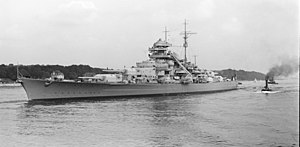
Back Bismarck (skip) Afrikaans البارجة الألمانية بسمارك Arabic Acorazáu Bismarck AST Бисмарк (линеен кораб) Bulgarian Cuirassat Bismarck Catalan Bismarck (1939) Czech Bismarck (slagskib) Danish Bismarck (Schiff, 1940) German Μπίσμαρκ (θωρηκτό) Greek Bismarck (batalŝipo) Esperanto
 Bismarck in 1940
| |
| History | |
|---|---|
| Name | Bismarck |
| Namesake | Otto von Bismarck |
| Builder | Blohm & Voss, Hamburg |
| Laid down | 1 July 1936 |
| Launched | 14 February 1939 |
| Commissioned | 24 August 1940 |
| Fate |
|
| Badge |  |
| General characteristics | |
| Class and type | Bismarck-class battleship |
| Displacement | |
| Length | |
| Beam | 36 m (118 ft 1 in) |
| Draft | 9.3 m (30 ft 6 in) standard[a] |
| Installed power | |
| Propulsion |
|
| Speed | 30.01 knots (55.58 km/h; 34.53 mph) during trials[1][b] |
| Range | 8,870 nmi (16,430 km; 10,210 mi) at 19 knots (35 km/h; 22 mph) |
| Complement |
|
| Sensors and processing systems |
|
| Armament |
|
| Armour |
|
| Aircraft carried | 4 × Arado Ar 196 floatplanes |
| Aviation facilities | 1 double-ended catapult |
Bismarck was the first of two Bismarck-class battleships built for Nazi Germany's Kriegsmarine. Named after Chancellor Otto von Bismarck, the ship was laid down at the Blohm & Voss shipyard in Hamburg in July 1936 and launched in February 1939. Work was completed in August 1940, when she was commissioned into the German fleet. Bismarck and her sister ship Tirpitz were the largest battleships ever built by Germany, and two of the largest built by any European power.
In the course of the warship's eight-month career, Bismarck conducted only one offensive operation that lasted 8 days in May 1941, codenamed Rheinübung. The ship, along with the heavy cruiser Prinz Eugen, was to break into the Atlantic Ocean and raid Allied shipping from North America to Great Britain. The two ships were detected several times off Scandinavia, and British naval units were deployed to block their route. At the Battle of the Denmark Strait, the battlecruiser HMS Hood initially engaged Prinz Eugen, probably by mistake, while HMS Prince of Wales engaged Bismarck. In the ensuing battle Hood was destroyed by the combined fire of Bismarck and Prinz Eugen, which then damaged Prince of Wales and forced her retreat. Bismarck suffered sufficient damage from three hits by Prince of Wales to force an end to the raiding mission.
The destruction of Hood spurred a relentless pursuit by the Royal Navy involving dozens of warships. Two days later, heading for occupied France for repairs, Bismarck was attacked by fifteen Fairey Swordfish torpedo bombers from the aircraft carrier HMS Ark Royal; one scored a hit that rendered the battleship's steering gear inoperable. In her final battle the following morning, the already-crippled Bismarck was engaged by two British battleships and two heavy cruisers, and sustained incapacitating damage and heavy loss of life. The ship was scuttled to prevent her being boarded by the British, and to allow the ship to be abandoned so as to limit further casualties. Most experts agree that the battle damage would have caused her to sink eventually.
The wreck was located in June 1989 by Robert Ballard, and has since been further surveyed by several other expeditions.
Cite error: There are <ref group=lower-alpha> tags or {{efn}} templates on this page, but the references will not show without a {{reflist|group=lower-alpha}} template or {{notelist}} template (see the help page).